Gas hoses: types of gas hoses + how to choose the best one
Since the appearance of the first gas appliances and until recently, they were connected only with steel pipes.
Now everything has changed dramatically: flexible gas hoses have become firmly established in everyday use, and have already managed to practically displace their outdated predecessors. They are much more convenient to use, easier and faster to connect to the main line.
Don't know what type of hose to choose from the range offered on the market? Let's figure it out together - the article discusses the main types of products used for gas connections, highlighting their advantages and disadvantages.
We also provide useful recommendations for choosing the best flexible eyeliner option. The material is supplemented with video tips and visual photos depicting hoses made of various materials.
The content of the article:
Types of gas hoses
There are many models of moving joints on the market. Among them, there are three main types of modern hoses for gas supply: rubber-fabric, reinforced, and bellows.
In the process of their production, different materials are used, which differ in technical characteristics, operating conditions and service life. Each type of product has both pros and cons. Which gas hose is best to choose depends on the specific situation, installation location, and household appliance.
Type #1 - products made of rubber and fabric
Rubber-fabric hoses are the simplest and cheapest option. These are soft rubber sleeves reinforced with durable textile thread. They are quite unpretentious to use.
The rubber from which the hoses are made is supplemented with elastic components that extend the service life up to 5 years. The material does not conduct electricity and bends well. However, over time it begins to crack, which is fraught with possible gas leaks.

Advantages of rubber products: affordable cost and quick installation, flexibility and excellent electrical insulation, availability of numerous models of different diameters and sizes.
But there are also disadvantages:
- high sensitivity to mechanical stress;
- minimal protection against temperature changes;
- insufficient rigidity.
This type of eyeliner is characterized by a high degree of danger. Even dielectric abilities cannot prevent the natural wear of rubber.
It is only allowed to be connected to gas cylinders, but subject to replacement every two years in order to prevent unpleasant consequences. Several brands of rubber hoses have positive reviews: IndustriasMateu, GasLink, Kuzuflex.
Type #2 - rubber hoses with metal braid
This variety is a reinforced sleeve made of vulcanized rubber, braided on the outside with steel threads. The internal part is made of polymer materials.
The polymer placed in the middle is subject to destruction and destruction in the same way as rubber. In addition, steel serves as a conductor of electricity.

When connecting such hoses, it is necessary to use additional dielectric inserts, placing them between the connection and the household appliance.
Product advantages:
- low price;
- ability to withstand high temperatures (up to 50 degrees);
- ease of installation and operation.
Disadvantages include the questionable reliability of internal polymer connections and the low level of electrical insulation.
Gas reinforced devices are easily distinguished from water ones by the color of the outer braid threads: they are usually marked yellow, and their water counterparts are red and blue. At the moment, the brands Ecoflex, GAS-FLEX, Fado are in demand.
Type #3 - bellows gas hoses
Flexible bellows-type devices are recognized as the most practical and safe type of gas supply. These are sealed sleeves made of stainless steel and polymer materials, reinforced with corrugation that follows the shape of a ring or screw. It contains a wire that can withstand high pressure.
At the ends of the products, fittings made of brass or carbon steel with threads, equipped with gaskets, are installed. Such elements are necessary for direct connection to the equipment.
According to manufacturers, flexible bellows lines are made by analogy with the structure of the human intestine. That is why they change sizes freely. By repeatedly bending, stretching and becoming significantly longer, the hoses do not lose their original elasticity, strength and performance.
In practice, it is not recommended to stretch the product by more than 50 percent of the original length, since this negatively affects its rigidity.

Simple models are presented in the form of a corrugated hose with a round cross-section, more advanced ones are protected by a special metal sleeve, and there are also products with a polymer coating.
You can also consider a modernized version - hoses equipped with a thermal protection valve that cuts off gas when the temperature rises critically. Corrugated tubes are produced in a characteristic bright yellow color.
Their main advantages:
- reliability and safety;
- flexible but rather dense structure;
- withstands a wide range of operating temperatures (-50…+250);
- resistance to high pressure (up to 6 atmospheres);
- possibility of extension twice;
- durability (service life about 30 years);
- compatibility with any gas equipment and fittings.
Professional gas fitters believe that this type of hose most closely matches European standards and is best suited for modern gas systems. But they have one significant drawback - high cost.
Corrugated tubes are often connected in open areas where devices constantly experience cyclic temperature changes. Trusted manufacturers of bellows hoses: Hydrosta, LAVITA, EMIFLEX, TuboFlex, Ayvaz.
View #4 - oxygen hoses
There is another type of gas connections - oxygen hoses. They are relatively inexpensive, have high strength, and can withstand high pressure (up to 20 atmospheres).
However, experts strongly do not recommend installing an oxygen hose in an apartment. Nowadays it is rarely found on new equipment.
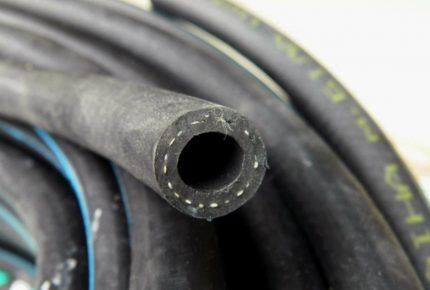
An oxygen hose is used as a temporary connection option, for example, at the dacha to connect a gas cylinder. In this case, do not forget to purchase and gas reducer to ensure the safety of using the cylinder.
For any gas appliance, you should use connections only with appropriate markings confirming that a particular device is intended specifically for gas. It is prohibited to use water hoses when connecting geysers or stoves.
Features of choosing the best hose
It is advisable to purchase hoses for supplying gas to household equipment in specialized stores that can provide a quality certificate for each product.
The range includes models of different lengths. It is selected so that in the future you do not have to connect several tubes to each other.
The most commonly used tubes are 1, 1.5 and 2 meters. This reduces the risk of line ruptures and, accordingly, increased danger for apartment residents. If the length is not enough, the supply is supplemented with a metal pipe.
Another important indicator is the cross-section diameter. The minimum value that will ensure good cross-country ability and full gas supply to the device is 10 mm.
The ends of the hoses are equipped with two nuts or one nut and a fitting. The nut has an internal thread, the fitting has an external thread. The thread is selected in accordance with the outlet on the household appliance.If the outlet is direct, then a special fitting-angle is used.

An ordinary rubber-fabric hose will do as a budget option. When choosing this product, you need to carefully monitor the degree of wear.
If the slightest cracks, damage or smell of gas is detected, replace it in a timely manner. When looking for an offer that would optimally combine price and quality indicators, it makes sense to focus on reinforced hoses.
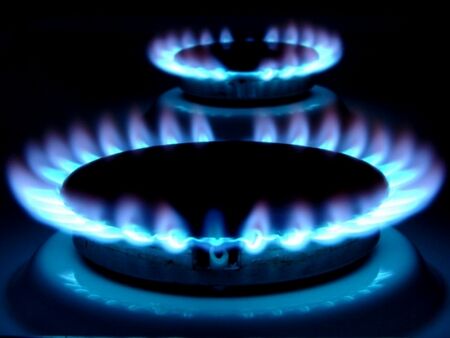
If finances allow, it is better to take a bellows hose. It is recognized as the safest and most reliable device - officially approved for use with household appliances by city gas services.
When choosing it, you need to check the type of connection. Its quality directly affects the durability of the product. It is not advisable to take models in which the fitting is connected to the corrugation using glue. It is more advisable to find a solid or welded structure.
Reliable signs of a fake
Regardless of the type of flexible gas hose, you should ensure the authenticity of the product before purchasing. The fact is that recently cases of defects and counterfeits launched for sale by Chinese manufacturers have become more frequent.
Well-known European brands are usually the targets of counterfeiting. The difference in quality between the original and the fake can be colossal.
It is possible to play it safe and distinguish a quality product from a counterfeit one.
To do this you need:
- take the time to conduct a thorough visual inspection;
- check whether the technical characteristics correspond to those indicated in the product passport;
- require the seller to present quality certificates confirming the safety of the device intended for working with explosive substances;
- do not buy goods at a suspiciously low price, which is not typical for products in this category.
The structure of counterfeit goods may contain dangerous chemical or radioactive impurities. Defective hoses are short-lived and often cause explosions.
Secure Connection Instructions
If you have at least minimal skills, you can connect the gas to the device yourself.
When working, you must adhere to the following rules:
- select the length of the line taking into account the distance over which the equipment will presumably move;
- place the device in a place accessible for visual inspection, without hiding it under the floor or in the wall;
- make sure that there are no other connections on the device (the exception is the wire that functions as a backlight in the oven);
- do not paint the product, as this leads to rapid cracking of the material;
- use gas hoses of standard sizes, provided for by the standards established by GOST;
- do not provoke electrolytic damage by connecting copper tips with steel ones (safe combinations: steel-steel, brass-copper);
- avoid twisting, bending and stretching of the sleeve;
- Do not expose connections to high temperatures (soldering, welding).
In multi-storey buildings, a common gas riser is installed, which has branches with taps at the ends. They are present in every apartment and are called omission.
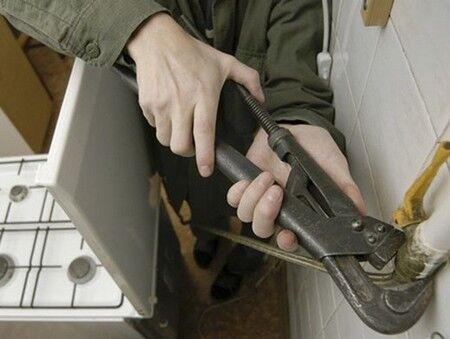
At the first stage of work, the room is prepared and the gas supply to the network is shut off. Then the equipment, be it a column or a slab, is placed at the installation site and carefully leveled.
After this, you need to apply a seal to the hose fitting and screw it into the tap on the lower side. If the thread on the device does not match the diameter of the sleeve, you will need an adapter, which also seals. Next, the hose is connected to the equipment.
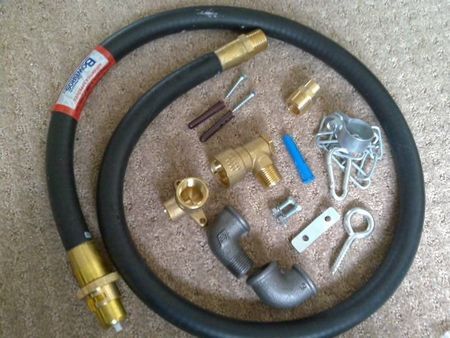
At the end, the tightness of the connecting elements is tested by opening the tap. This can be easily done using ordinary soap emulsion and a small brush.
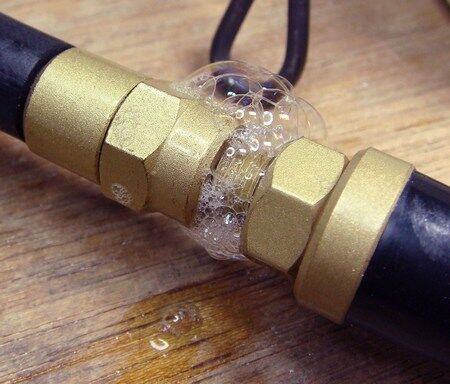
If insufficient connection density is detected, the tap handle is lightly screwed together and the winding is checked. The last step is to diagnose the functionality of the equipment and gas supply.
The best solution if you lack confidence in your own abilities is to turn to gas workers. Our specialists will carry out the connection in compliance with all standards, which will guarantee that the system will function properly, safely and reliably for many years.
Our website has detailed instructions on how to replace a gas hose and how to connect various gas equipment.
We invite you to familiarize yourself with these materials:
- Replacing a gas hose with your own hands: rules for installation work
- How to move a gas pipe in an apartment: transfer rules and location tips
- Connecting a gas stove with your own hands: how to install a gas stove in an apartment step by step
- Connection diagram for a double-circuit gas boiler: how to properly supply gas to the boiler
- Installing a geyser in an apartment with your own hands: requirements and technical standards for installation
Conclusions and useful video on the topic
More details about the main types of flexible eyeliners in the video:
Video instructions for connecting the stove to gas:
Gas water heater connection diagram in the video clip:
Thanks to universal flexible hoses, it has become possible to avoid connecting household appliances “tightly” to gas pipes. The mobility of such devices greatly simplifies the life of kitchen owners, allowing them to move equipment for cleaning, rearrangement or repair without much difficulty.
What type of hose did you choose to connect gas at home? Tell us, which of the advantages of eyeliner was the main reason for choosing it? How long have you been using this flexible hose?
Or maybe you noticed an inaccuracy in the material reviewed or want to add your own opinion to what was said above? Please leave your comment under our article.




I changed the gas hose due to the installation of a new stove. The old one was rubber, I installed a bellows one, and based on all the criteria I decided that it was more reliable, although it was much more expensive.At first I wanted to do everything myself, but I was afraid and called the gas man. When they checked the hose for leaks, it was discovered that it was “poisoning”. I had to go to the store and exchange it for another one, it turned out that there was a manufacturing defect.
Hello, Vladimir. Well, in any case, you could check for yourself whether the hose is poisoning or not, in the old fashioned way. It was necessary to smear it with soapy liquid: if it foams, it means it’s poisoning, if not, then it’s okay! But you did absolutely the right thing by calling the experts, gas is no joke! As for me, both hoses have their disadvantages and advantages. If you need a very long hose, then it is better to buy a rubber one (or you need to twist several reinforced ones with a nipple, and this is an unnecessary connection), and rubber is more flexible, of course. But in terms of strength, I trust reinforced and bellows ones more, although they are an order of magnitude more expensive!
Tell me, please, are there any restrictions on the length of the hose? Can it be bent? I need to hide the hose that will go to the stove. Thanks for the answer.
According to European standards, the maximum length is two meters. In our SNiP, the length of the gas hose is not limited in any way (clause 7.3 of Section 7 “Internal gas pipelines”). There are also no restrictions on bending.
Hello.
According to clause 3.21 of the Moscow standard for the operation of the housing stock ZhNM-2004/03 “Gas pipelines and gas equipment of residential buildings”, approved and put into effect by Decree of the Moscow Government dated November 2, 2004 No. 758-PP: “Connecting gas appliances to the gas pipeline is allowed through a flexible liner that does not have butt connections and has a heat resistance of at least 120 degrees«.
The same thing is said in ZHM-2004/03 “Gas pipelines and gas equipment of residential buildings”, paragraph 3.21 (as amended as of January 30, 2013).
But not only for the capital, the technical regulations of the VDGO:
«9.6. The design of the detachable connection at the points where the flexible hose is connected to the internal house gas pipeline and household gas-using equipment must ensure the tightness of the connections. Flexible hoses for connecting household gas-using equipment to the gas consumption network or to an individual cylinder installation must meet the following requirements:
1) have no connections;
»2) correspond to the parameters of the gas used;
3) have a service life of at least ten years.
For general rules, SP 41-108-2004, recommended by paragraph 5.5 (document of voluntary application):
«The connection of heat generators to the gas pipeline may be provided using steel, copper or flexible connections, including non-metallic pipes that have the necessary strength characteristics for long-term (at least 25 years) exposure to the transported gas. The length of flexible connections should be no more than 1.5 m. Flexible connections to heat generators must have a certificate of conformity«.
GOST R 52209-2004 2.2.2 Gas hoses and braid: “To make a gas hose, use a tape made of austenitic steel grade 12Х18Н10Т in accordance with GOST 4986, the braid is made of wire 12Х18Н10Т in accordance with GOST 18143.»
In Ukraine, the DNB limits the length of the supply hose to 2 meters.
A hose in a brass (yellow metal) braid with black strokes in a spiral was sold in a store as for connecting a liquefied gas cylinder to a gas water heater.The hose ends are made of white steel, the inlet on the column is yellow... I can’t find a word about such hoses anywhere. Is it possible to connect a cylinder and a column with it? It is written that the water hose...
Hello. Please describe to us the markings on the hose and take a photo of it, we will try to help you.
Good afternoon.
Due to the rigid connection of the meter to the gas pipeline and the rigid connection of the meter to the flow line, gas leakage occurs in the threaded connections on the meter.
Can a soft connection (bellows hose) be used and where before or after the meter?
connection diameter 1 inch.
Thank you
Hello, please tell me, if there is a microwave oven next to the gas hose (the hose will be behind the microwave), then which hose is best to run?